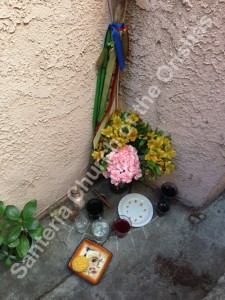
The Lucumí Ancestral Shrine at our church with offerings of food, drinks and cigar.
Honoring the Ancestors is of primary importance in all Lucumí rituals and practices. The Ancestors come before the orishas and must be given their due attention and offerings before proceeding with any initiation, ritual or festival. Ancestors are typically honored with food offerings, drinks, flowers, prayers, cigar smoke, libations of water (omí tutu) and coconut as well as other offerings they might like.
Who are the Ancestors?
The Ancestors are known collectively as Egun. Egun includes your ancestors of blood lineage but also ancestors of initiatory lineage. This includes the priests and priestesses who initiated you, your godparents, their godparents and back to the very start of the Lucumí faith. Egun does not include spirit guides like your gypsy spirit. Egun does not include the Seven African Powers. Egun does not include elevated masters like Buddha and Jesus nor does it include saints like St. Michael. These other spirits that are not of your blood or initiatory lineage are called Ará Orún (sometimes mispronounced Ará Onú) – citizens of heaven. They are not propitiated at the Lucumí Ancestral Shrine. They can be propitiated at the bóveda (altar of Espiritismo).
For those who were adopted, Egun include the people you never knew that gave birth to you and to whom you are related by blood. In my opinion they also include the family that raised you as they are the ones who supported you and got you to where you are today.
The Traditional Lucumí Ancestral Shrine
The traditional Lucumí Ancestral Shrine, sometimes called “el rinconcito del muerto”, is typically set up on the ground in the corner of a room like the kitchen or bathroom, or placed outdoors against a wall. The Lukumí Ancestral Shrine should be located away from where the orishas are kept, and should be on the ground level of a building to connect it to the earth – where the ancestors are buried. The odd tradition of placing this shrine in the bathroom or kitchen seems to originate from the fact that the pipes in these rooms bury themselves down into the earth, providing a direct connection to the ancestors buried within the land.
The traditional Lukumí Ancestral Shrine is typically set up by drawing a circle with chalk or cascarilla (efun) half on the wall and half on the ground. This represents the sun setting in our world but rising in the world of the dead. Typically nine “rays” are drawn on the half of the circle that is drawn on the ground. Within this circle are placed cooked food offerings, drinks, candles and other offerings for the dead. Additionally, the opá ikú (staff of the dead) is leaned against the wall next to this shrine and is used to call upon the dead by tapping it on the ground as prayers are recited in their honor. Some houses also include a terra-cotta tile specially prepared by babalawos with odu painted on it that represent and invoke the spirits of Egun. It is also traditional to include a bundle of nine sticks of the plant mar pacífico (hibiscus) in this shrine, due to the plants connection with spirits of the dead (although some houses use rasca barriga or other plants associated with egun). Some lineages consecrate an otán (stone) as the seat of Egun to place at the shrine but we do not follow this tradition at the Santería Church of the Orishas.
Making Offerings to Egun at the Lukumí Ancestral Shrine
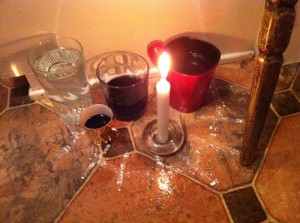
A small Lucumí ancestral shrine with drinks and a candle.
Making offerings at the Lukumí Ancestral Shrine is simple. Just prepare any special foods your ancestors might like and place them on plates around the shrine. It is common to use chipped or cracked plates for the ancestors as this hearkens to the practice of smashing plates on the ground at the death of a Lucumí priest. It is common to offer 9 different types of beverages. You can include coffee, tea, rum or other kinds of spirits. I even offer some soda to my spirits because I know they enjoyed their coca-cola when they were alive. After you’ve placed all of your foods and drinks around the shrine, light a white candle for Egun to give them light. It is also nice to light up a cigar and offer them some of the tobacco smoke as well. (If you have Native American ancestry it might not be a good idea to include booze without divining first to see if this is ok with your ancestors considering how devastating alcohol has been to the Native population.)
It is also nice to place a bouquet of fresh flowers in a vase near the shrine as an offering to the spirits. Flowers are a traditional way of honoring the dead. Some people make the mistake of offering flowers to the orishas, but this is not proper. The odu Osa-Irosun (9-4) clearly indicates that flowers are for the dead, not the orishas.
When offerings are left at the Lucumí Ancestral Shrine is is traditional to tap the opá ikú (staff of the dead) on the ground as you recite the Yuba (or Moyuba) to awaken and honor your Egun, and to call them to the meal. Your godparent can give you a Yuba to pray that is associated with your lineage. Calling out the names of your ancestors and offering them praise will let them know you’ve prepared the meal for them.
If offerings are being given prior to a ceremony, an Olorisha or Oriaté will then divine with Obí (coconut oracle) to see if Egun gives their permission to proceed with the ceremony. If Egun does not give permission to proceed then the priest will use Obí to determine what is lacking and what Egun needs to give the green light to proceed.
Throughout the day, It is traditional to offer the first serving of every dish cooked to Egun by placing a little piece on a plate and setting it out by the Lucumí Ancestral Shrine. When you place offerings at the shrine, they are left until they start to go bad at which point they can be removed and disposed of. It is not uncommon for food or drinks left at the Lucumí Ancestral Shrine to be moldy. It’s the nature of death and most priests will shrug it off and clean it when they get a chance. It’s a good idea to attend to your Egun at the Lucumí Ancestral Shrine about once a week or once a month minimum.


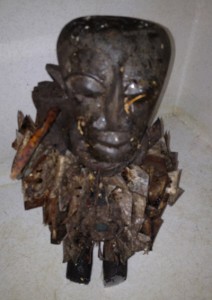
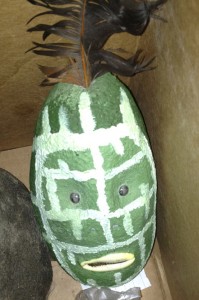
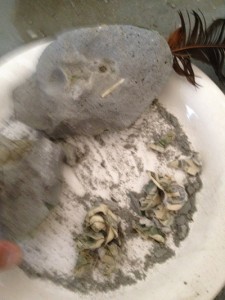
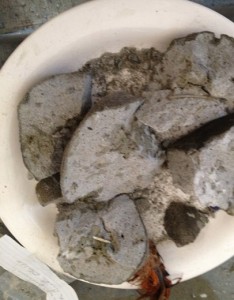
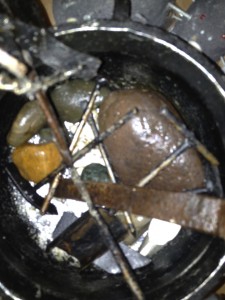
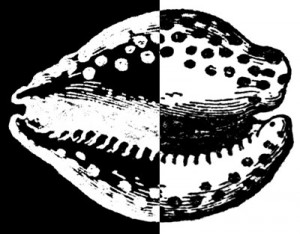
 Pagan Blog Project
Pagan Blog Project
Follow Us!